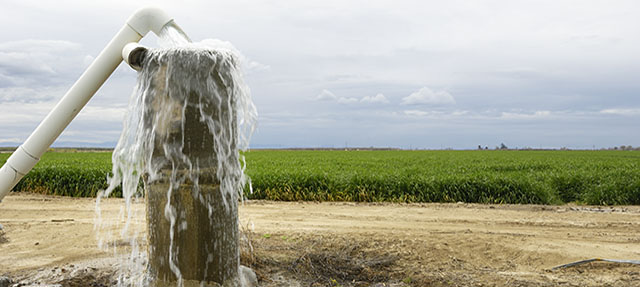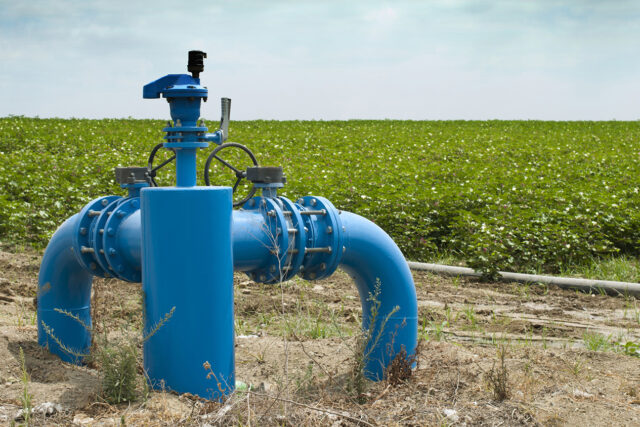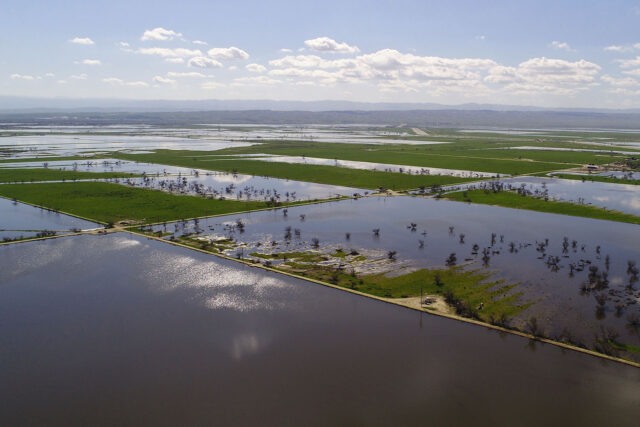groundwater (ground·wa·ter \-wȯ-tər, -ˌwä-\ Water beneath the land surface that fills pore spaces in underlying soil or rock.
Groundwater is a critical part of California’s water supply—on average, underground aquifers provide nearly 40% of the water used by the state’s farms and cities, and more in dry years. But after decades of unsustainable pumping in many basins, the state is undergoing major changes in how it manages this resource. The Sustainable Groundwater Management Act (SGMA) requires water users to develop plans to bring their basins into balance in coming years and encourages wide public participation in the planning process. Knowing some of the vocabulary is key to engaging in the conversation. This glossary will get you started.
Adjudication: A lack of clarity over how much groundwater individuals can pump has caused conflict in some places. In more than two dozen basins, mostly in Southern California, the courts have been asked to settle—adjudicate—disputes over groundwater pumping rights. Adjudicated basins must report how much water is being pumped, but most other basins are not yet required to do so.
Conjunctive use: The coordinated management of surface water and groundwater to make the best use of surface water during wet periods and groundwater during dry periods. Expanding this practice can require changing how surface reservoirs are operated, to allow the release of more water during the fall to replenish aquifers and increase reservoirs’ capacity to hold winter runoff.
Conveyance: The infrastructure needed to move surface water to where it can be used, including to areas suitable for recharging aquifers. In some parts of the state, this infrastructure is in poor condition or is missing links, creating barriers to getting more water into underground storage.
Glide path: A gradual approach to implementing SGMA, to give water users time to adjust and prevent major disruptions in the regional economy. Most groundwater sustainability agencies in the San Joaquin Valley—where overdraft is a major issue—are likely to adopt this approach. The result is that groundwater levels will continue to decline, but at a decreasing rate, until they reach long-term balance.
Groundwater sustainability agencies (GSAs): Local agencies formed to develop groundwater sustainability plans to manage their resources for the long run. More than 250 GSAs in 140 “priority basins” (which account for most of California’s groundwater use) have been formed.
Overdraft: When groundwater extraction exceeds what is being replenished (also called “groundwater mining”). Its repercussions can include drying wells, sinking lands, reduced streamflow, degraded water quality, and higher energy use from pumping water from deeper depths.
Recharge: Taking action to replenish underground aquifers with surface water (also known as “managed recharge” to distinguish it from natural recharge). This water can come from a variety of sources, including flood- and stormwater, treated wastewater, and spare surface water. Recharge usually involves spreading water on the land. Some water districts have dedicated recharge basins, but individual farms can also help by recharging on their lands. “In lieu” recharge is when farmers enable the aquifer to replenish naturally by pumping less and using surface water instead. One challenge is coming up with ways to compensate farmers who recharge shared basins under their land.
Safe or sustainable yield: The amount of water that can be withdrawn from a groundwater basin without causing problems—such as a significant drop in water levels, harm to groundwater-dependent ecosystems, land subsidence, and saltwater intrusion, to name a few.
Saltwater intrusion: Many coastal aquifers—for example, those on the Central Coast—are overdrafted, which reduces groundwater flow toward the sea and allows saltwater to move in.
Subsidence: Land surfaces can sink in overdrafted basins, which damages infrastructure such as bridges, reservoirs, and water canals. Parts of the San Joaquin Valley have been sinking by more than half a foot annually. Subsidence has reduced capacity in the Friant-Kern Canal, the Delta Mendota Canal, and the California Aqueduct.
Sustainable Groundwater Management Act: Requires water users in most groundwater basins to develop and implement groundwater sustainability plans to bring groundwater use and recharge into balance by the early 2040s. The challenges are particularly big in the San Joaquin Valley and the Central Coast.
White areas: Areas that rely entirely on groundwater for drinking water and irrigation supplies. Water users in these areas—which are shown in white on irrigation district maps—are particularly susceptible to groundwater quality problems and falling water tables, and are vulnerable to pumping restrictions with the implementation of SGMA.




